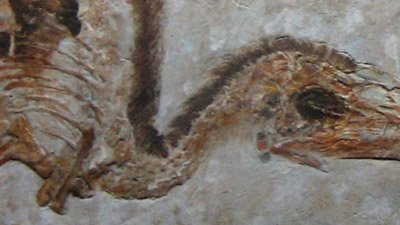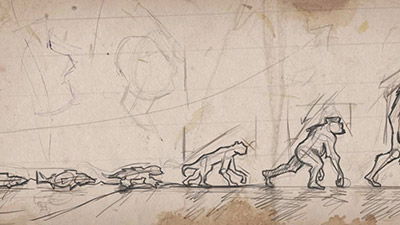Missing Links
No Missing Links
In 2000, the Human Genome Project announced to the world that all humans biologically belong to one race. Although the people heading this project did not acknowledge it, they confirmed the Bible—that all people are descendants of Adam and Eve and all belong to one biological race.
Tiktaalik
Despite substantial differences between the fossilized fish Tiktaalik and terrestrial tetrapods, many evolutionists insist the fish was a transitional form. Many evolutionists maintain its fins were antecedents to legs. However, the fleshy fins of Tiktaalik do not attach to the bony pelvis and so could not support weight for walking.
Archaeopteryx
Evolutionists have pointed to fossils of the iconic Archaeopteryx as the earliest example of birds evolving from reptiles. It was the quintessential “missing link,” though creationists countered that it was just a bird, similar to those flapping around today. A new find is forcing evolutionists to sideline Archaeopteryx and change their story.
Ardi
The facts seem solidly behind the idea that Ardi was a quadrupedal ape with relatively little in common with human. As far as we’re concerned, the evolutionary “threat” to creationists from Ardi is no more than that posed by Ida: viz., none.
Missing Links Topics
-
Feathered Dinosaurs?
Did birds really evolve from dinosaurs? How should Christians understand the numerous claims of feathered dinosaurs used to support this idea?
-
Transitional Fossils
Evolution predicts a fossil record bursting with transitional fossils. Curiously, there are only a handful of highly-disputed fossils that are claimed as such.
News About Missing Links
-
Jan. 28, 2021 from Ken Ham Blog
The unique Australian lungfish is making headlines for having an astoundingly large genome. So why does it matter?
Articles About Missing Links
-
Jan. 1, 2023 from Answers Magazine
No matter how hard they try, scientists can’t connect the missing links in human evolution. Why not?
-
Sept. 4, 2021 from Answers Magazine
We’ve all heard about “missing links”—supposed races of human-like people who were similar to us but not as intelligent or skilled.
-
Nov. 20, 2015 from Answers in Depth
Some believe the Gibbon-like fossil Pliobates cataloniae sheds light on the common ancestor supposedly shared by monkeys, apes, and humans.
-
In-Depth ArticleDoes “Loki” Show How Humans Evolved from Single-Celled Organisms?June 11, 2015 from Answers in Depth
Single-celled organisms called Lokiarchaeota are making headlines as missing links in our supposed single-celled ancestry.
-
Book ChapterIs Tiktaalik Evolution’s Greatest Missing Link?July 11, 2014 from The New Answers Book 3
The media’s excitement over Tiktaalik seems to mostly come from being able to discredit the biblical account of creation.
-
Magazine Department ArticleIf Fish Could Walk . . .July 1, 2014 from Answers Magazine
Tiktaalik has been touted as evidence of how a limbless fish could turn into an amphibian.
-
In-Depth ArticleMissing Link Found? Fossil Fish Face Flips Humanity’s “Evolutionary History” on Its HeadSept. 28, 2013 from Answers in Depth
Jaws of life get an evolutionary face-lift from “a bony-fish-like grin.”
-
Cousin Achilles: The Little Primate That CouldJune 15, 2013 from News to Know
An ounce of primate prompts a pound of speculation.
-
Jan. 1, 2012 from Answers Magazine
A new find has forced evolutionists to sideline Archaeopteryx and change their story.
-
Lungfish Studied to Determine Transitional EvolutionDec. 17, 2011 from News to Know
Lungfish lurch and shimmy to show the way up the evolutionary ladder.
-
-
Middle Ear Missing Links?April 23, 2011
The fossilized mammal Liaoconodon hui, found in China, is being hailed as the missing link in middle ear evolution from reptiles to mammals.
-
Another Missing LinkApril 10, 2010
Is it time already for the announcement of yet another alleged “missing link”? Apparently so!
-
"Missing Link" Cut ShortMarch 6, 2010 from News to Know
Many readers have probably forgotten “Ida,” the fossil primate whose fifteen minutes of media-frenzied fame as a “missing link” was cut short.
-
Bye-Bye, Missing LinkOct. 3, 2009 from News to Know
Although first discovered in the early 1990s, the bones of Ardipithecus ramidus are only now being nominated for evolutionists’ fossil hall of fame.
-
HIV Missing Link?July 25, 2009 from News to Know
Hot news about chimps, “missing links,” and evolution—but the story has nothing to do with human origins or anthropology. What could it be?
-
Hype and Science Don't MixMay 23, 2009 from News to Know
The news media has been awash this week in hype over an alleged missing link fossil nicknamed Ida. As it turns out, the fossil wasn’t fraudulent, but the hype definitely was.
-
Ida (Darwinius masillae): the Real Story of this “Scientific Breakthrough”May 21, 2009
So-called “missing link” Ida hit the media in a major way on Monday of this week. Yet within a few hours of the unveiling of the fossil, the better media outlets began to report the real story.
-
Ida (Darwinius masillae): the Missing Link at Last?May 19, 2009
Does Ida, the latest “missing link,” really support human evolution?
-
The Weakest LinkMay 16, 2009 from News to Know
Although not yet officially unveiled, a new missing link is the focus of a forthcoming BBC documentary hosted by Sir David Attenborough.
-
It's a 'Whale'Feb. 7, 2009 from News to Know
Does the fossil discovery of an early “whale” offer evidence for evolution or does it merely reinforce presuppositions?
-
A Sea of Change for Turtle Origin TheoriesDec. 6, 2008
Turtle evolution is yet again in the news—and, yet again, the evolution is only in evolutionists’ minds.
-
Turtle Missing Link Found In ScotlandNov. 22, 2008
For the second time in two months, a turtle “missing link” is in the news.
-
From Water to Land: The Evolutionary Transition RevealedOct. 18, 2008
The supposed missing link Tiktaalik is back in the news, rearing its ugly “evolutionary” head on the supposed transitional element of a mobile neck.
-
Mystery of the Turtle ShellOct. 11, 2008
The turtle is known for its slow speed. So was turtle evolution so slow that you can’t even see it?
-
Scientists Discover Another Suspicious Missing LinkJuly 12, 2008
Scientists have discovered yet another missing link—but like others, this one strikes us as a little fishy.
-
Magazine Department ArticleLanded—a Missing Link?July 1, 2008 from Answers Magazine
Paleontologists have found a fossil they tout as the missing link that connects whales and dolphins to land mammals.
-
Fish-to-Tetrapod Missing Link FoundJune 28, 2008
According to a much-ballyhooed report in Nature, scientists have found another fish-to-tetrapod “missing link.” Just don’t read the fine print.
-
Missing Link May Have Shuffled on Its Way to BipedalismJune 7, 2008
Might the missing link have done a dance move on its way to bipedalism?
-
Magazine Department ArticleFor the Birds?Feb. 4, 2008 from Answers Magazine
Paleontologists say they have found a 100-million-year-old missing link, named Gansus, in the evolution of birds.
-
River-Slosher—Missing Link?Dec. 22, 2007 from News to Know
A team of paleontologists has “identified” a fossil as the missing link connecting land mammals to supposed evolutionary kin of whales, dolphins, and porpoises.
-
Gone Fishin’ for a Missing Link? (A Preliminary Response)April 6, 2006
The secular press has been buzzing over a report that a fossil had been found in the Arctic that supposedly proves that land animals evolved from fish.
-
Read the Fine Print—A Preliminary Comment on Saturday’s “Missing Link” Claim in EthiopiaMarch 26, 2006
Researchers working in Ethiopia declared over the weekend that they have discovered “the skull of a small human ancestor that could be a missing link between the extinct Homo erectus and modern man”
-
Technical Research PaperBird Evolution: Discontinuities and ReversalsApril 1, 2003, pp. 88–94
Theropod dinosaurs, widely accepted as the ancestors of birds, do not show a step-by-step gradational change to Archaeopteryx, the first known bird.
-
Technical Research PaperWalking Whales, Nested Hierarchies, and Chimeras: Do They Exist?April 1, 2002, pp. 111–119
The trends cited in whale evolution are rather superficial in nature, and little different from those that become apparent by lining up wheeled vehicles within a cladogram.
-
Another “Missing Link” Takes FlightOct. 16, 2000
In a case that smacks of the Piltdown Man forgery early last century, National Geographic magazine has admitted to having egg on its face due to an item it published in November 1999.
-
Semi-Technical Research PaperDoes a ‘Transitional Form’ Replace One Gap with Two Gaps?Aug. 1, 2000, pp. 5–6
Creationists are often ridiculed for pointing to gaps in the fossil record. It is alleged, the finding of a ‘transitional form’ means that one can now argue two gaps in the fossile record.
-
Magazine ArticleThe Taung Skull: ‘Missing Link’?Dec. 1, 1993, pp. 16–17
Dart’s discovery of a skull in lime works at Taung did not legitimize the evolution theory, but rather caused great debate among scientists of the day, raising questions which have yet to be answered.
-
Semi-Technical Magazine ArticleYet Another ‘Missing Link’ Fails to QualifyJune 1, 1993, pp. 40–44
A fossil truly ‘in-between’ the crucial fish and amphibian characters is not only hard to conceive, but has never been found.
-
Magazine ArticleFinding the Real 'Missing Link'Sept. 1, 1991, pp. 4–5
Some of the most inconclusive and misleading reports ever published fall into the category of alleged evolutionary breakthroughs.

Answers in Genesis is an apologetics ministry, dedicated to helping Christians defend their faith and proclaim the good news of Jesus Christ.
- Customer Service 800.778.3390
- Available Monday–Friday | 9 AM–5 PM ET
- © 2026 Answers in Genesis








